The document discusses arrays and their representations in C language. It defines arrays as collections of similar data types stored in contiguous memory locations. It describes one-dimensional and two-dimensional arrays, and provides examples of declaring, initializing and accessing elements of arrays. Formulas to find the address of elements in one-dimensional and two-dimensional arrays are also presented along with problems and their solutions. Sparse matrices and different representations like array and linked list to store only non-zero elements are explained as well.
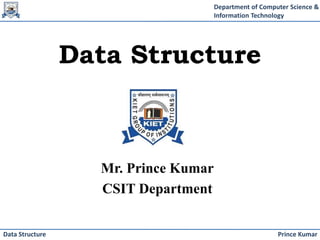
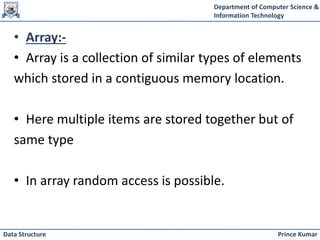
![Department of Computer Science &
Information Technology
Prince Kumar
Data Structure
• Example
• Without array:
• int a=10; int b=20; int a=30; int b=40; int a=50;
int b=60; int a=70; int b=80;
• With array:
• Syntax of array in C language:
datatype name_of_array[size]={element1, element2.....element_n}
Above example using array
int arr[8]={10,20,30,40,50,60,70,80}](https://image.slidesharecdn.com/datastructurearrayandsparsematrix-240131151926-f589454c/85/Data-Structure_Array_and_sparse-matrix-pptx-3-320.jpg)
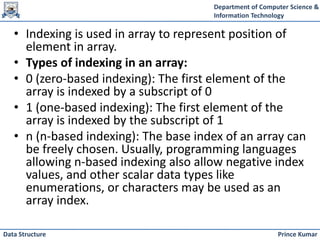

![Department of Computer Science &
Information Technology
Prince Kumar
Data Structure
• To access array elements syntax is:
• arr_name[element_index_value];
Example:
int arr[5]={1,2,3,4,5};
//index= 0,1,2,3,4
To Access
arr[4];](https://image.slidesharecdn.com/datastructurearrayandsparsematrix-240131151926-f589454c/85/Data-Structure_Array_and_sparse-matrix-pptx-6-320.jpg)

![Department of Computer Science &
Information Technology
Prince Kumar
Data Structure
• One – dimensional array
• The Syntax is as follows −
• datatype array_name [size];
• For example, int a[5]={10,20,30,40,50}](https://image.slidesharecdn.com/datastructurearrayandsparsematrix-240131151926-f589454c/85/Data-Structure_Array_and_sparse-matrix-pptx-8-320.jpg)
![Department of Computer Science &
Information Technology
Prince Kumar
Data Structure
• Example
• Following is the C program in which array is used
#include<stdio.h>
int main ( )
{
int a[5] = {10,20,30,40,50};
printf ("elements of the array are");
for ( int i=0; i<5; i++)
{
printf ("%d", a[i]);
}
return 0;
}](https://image.slidesharecdn.com/datastructurearrayandsparsematrix-240131151926-f589454c/85/Data-Structure_Array_and_sparse-matrix-pptx-9-320.jpg)
![Department of Computer Science &
Information Technology
Prince Kumar
Data Structure
• Numerical Problem on 1 Dimensional Array:
Problem:- Using random access find i’th element
address of array.
Q)A[lb............ub],BA,Size of element=s,Loc(a[i])=?
Formula used:-
A[i]=BaseAddress+(i-lowerbound)*s
Find i’th
element
address
It is first
address
of array
i is index
value of
which
we want
to find
address
Starting
index
Size of
each
element
in array](https://image.slidesharecdn.com/datastructurearrayandsparsematrix-240131151926-f589454c/85/Data-Structure_Array_and_sparse-matrix-pptx-10-320.jpg)
![Department of Computer Science &
Information Technology
Prince Kumar
Data Structure
• Problem 1
int a[10];
int a[0.......9]={10,20,30,40,50,60,70,80,90,100}
• Loc(a[5])=?
• Solution
• Loc(a[5])=100+(5-0)*2=110
Upper
bound
Lower
bound](https://image.slidesharecdn.com/datastructurearrayandsparsematrix-240131151926-f589454c/85/Data-Structure_Array_and_sparse-matrix-pptx-11-320.jpg)
![Department of Computer Science &
Information Technology
Prince Kumar
Data Structure
• Problem 2
• Loc(a[9])=?
• Array Representation(For Verification of answer)
index 0 1 2 3 4 5 6 7 8 9
Arr_name 10 20 30 40 50 60 70 80 90 100
Address 100 102 104 106 108 110 112 114 116 118](https://image.slidesharecdn.com/datastructurearrayandsparsematrix-240131151926-f589454c/85/Data-Structure_Array_and_sparse-matrix-pptx-12-320.jpg)
![Department of Computer Science &
Information Technology
Prince Kumar
Data Structure
Problem 3
A[24............900],B.A=500,Size of element=8
Loc(a[625])=?
Problem 4
A[-65.............+973],BA=1000,Size of element=6
Loc(A[725])==?](https://image.slidesharecdn.com/datastructurearrayandsparsematrix-240131151926-f589454c/85/Data-Structure_Array_and_sparse-matrix-pptx-13-320.jpg)



![Department of Computer Science &
Information Technology
Prince Kumar
Data Structure
• General form of declaring N-dimensional arrays:
data_type array_name[size1][size2]....[sizeN];
data_type: Type of data to be stored in the array.
Here data_type is valid C/C++ data type
array_name: Name of the array
size1, size2,... ,sizeN: Sizes of the dimensions](https://image.slidesharecdn.com/datastructurearrayandsparsematrix-240131151926-f589454c/85/Data-Structure_Array_and_sparse-matrix-pptx-17-320.jpg)
![Department of Computer Science &
Information Technology
Prince Kumar
Data Structure
• Examples:
• Two dimensional array: int two_d[10][20];
• Three dimensional array: int
three_d[10][20][30];](https://image.slidesharecdn.com/datastructurearrayandsparsematrix-240131151926-f589454c/85/Data-Structure_Array_and_sparse-matrix-pptx-18-320.jpg)
![Department of Computer Science &
Information Technology
Prince Kumar
Data Structure
• We can declare a two dimensional integer array
say ‘x’ of size 10,20 as:
int x[10][20];
Elements in two-dimensional arrays are
commonly referred by x[i][j] where i is the row
number and ‘j’ is the column number.A two –
dimensional array can be seen as a table with ‘x’
rows and ‘y’ columns where the row number
ranges from 0 to (x-1) and column number
ranges from 0 to (y-1).](https://image.slidesharecdn.com/datastructurearrayandsparsematrix-240131151926-f589454c/85/Data-Structure_Array_and_sparse-matrix-pptx-19-320.jpg)

![Department of Computer Science &
Information Technology
Prince Kumar
Data Structure
• Initializing Two – Dimensional Arrays: There are
two ways in which a Two-Dimensional array can be
initialized.
First Method:
int x[3][4] = {0, 1 ,2 ,3 ,4 , 5 , 6 , 7 , 8 , 9 , 10 , 11}
The above array have 3 rows and 4 columns. The
elements in the braces from left to right are stored
in the table also from left to right. The elements will
be filled in the array in the order, first 4 elements
from the left in first row, next 4 elements in second
row and so on.](https://image.slidesharecdn.com/datastructurearrayandsparsematrix-240131151926-f589454c/85/Data-Structure_Array_and_sparse-matrix-pptx-21-320.jpg)
![Department of Computer Science &
Information Technology
Prince Kumar
Data Structure
• Better Method:
int x[3][4] = {{0,1,2,3}, {4,5,6,7}, {8,9,10,11}};
This type of initialization make use of nested braces.
Each set of inner braces represents one row. In the
above example there are total three rows so there
are three sets of inner braces.
To access elements of 2d array:-
For example to access 2nd element of 3nd row
X[2][1];](https://image.slidesharecdn.com/datastructurearrayandsparsematrix-240131151926-f589454c/85/Data-Structure_Array_and_sparse-matrix-pptx-22-320.jpg)

![Department of Computer Science &
Information Technology
Prince Kumar
Data Structure
#include<stdio>
int main()
{
int x[3][2] = {{0,1}, {2,3}, {4,5}};
for (int i = 0; i < 3; i++)
{
for (int j = 0; j < 2; j++)
{
printf(“%d”,x[i][j]);
}
printf(“n”);
}
return 0;
}](https://image.slidesharecdn.com/datastructurearrayandsparsematrix-240131151926-f589454c/85/Data-Structure_Array_and_sparse-matrix-pptx-24-320.jpg)

![Department of Computer Science &
Information Technology
Prince Kumar
Data Structure
• We can represent 2d array in two ways:
• 1) Row major order
• Int a[1.....4][1.......5]
Number of rows= ub1-lb1+1
Number of columns= ub2-lb2+1
Lower
bound1
Upper
bound1
Lower
bound 2
Upper
bound 2](https://image.slidesharecdn.com/datastructurearrayandsparsematrix-240131151926-f589454c/85/Data-Structure_Array_and_sparse-matrix-pptx-26-320.jpg)
![Department of Computer Science &
Information Technology
Prince Kumar
Data Structure
• Problems
• Q) a[lb1.........ub1][lb2...........ub2],BA,Size of
element =s,loc(a[i][j])=?
• Formula:
• loc(a[i][j])=? BA+((a[i]-lb1)*(ub2-lb2+1)+j-lb2)*s
Find i’th
row, j’th
column
element
address
It is first
address
of array
Number
of
column Size of
each
element
in array](https://image.slidesharecdn.com/datastructurearrayandsparsematrix-240131151926-f589454c/85/Data-Structure_Array_and_sparse-matrix-pptx-27-320.jpg)
![Department of Computer Science &
Information Technology
Prince Kumar
Data Structure
• Problem 1)
• Int a[1.....4][1.......5]
• BA=100, Size of element =2
• Loc(a[4][3])=?
• Problem 2
• Problem 2)
• Loc(a[2][5])=?](https://image.slidesharecdn.com/datastructurearrayandsparsematrix-240131151926-f589454c/85/Data-Structure_Array_and_sparse-matrix-pptx-28-320.jpg)
![Department of Computer Science &
Information Technology
Prince Kumar
Data Structure
• Problem 3)
• A[75.....198][-21.........+155],BA=500,Size of
element=8
• Loc(a[100][103])=?](https://image.slidesharecdn.com/datastructurearrayandsparsematrix-240131151926-f589454c/85/Data-Structure_Array_and_sparse-matrix-pptx-29-320.jpg)

![Department of Computer Science &
Information Technology
Prince Kumar
Data Structure
• Problems
• Q) a[lb1.........ub1][lb2...........ub2],BA,Size of
element =s,loc(a[i][j])=?
• Formula:
• loc(a[i][j])=? BA+((a[j]-lb2)*(ub1-lb1+1)+j-lb1)*s
Find i’th
row, j’th
column
element
address
It is first
address
of array
Number
of rows
Size of
each
element
in array](https://image.slidesharecdn.com/datastructurearrayandsparsematrix-240131151926-f589454c/85/Data-Structure_Array_and_sparse-matrix-pptx-31-320.jpg)
![Department of Computer Science &
Information Technology
Prince Kumar
Data Structure
• Problem 1
• Int a[1.....4][1.......5]
• BA=100, Size of element =2
• Loc(a[3][5])=?
• Problem 2
• Loc(a[3][3])=?](https://image.slidesharecdn.com/datastructurearrayandsparsematrix-240131151926-f589454c/85/Data-Structure_Array_and_sparse-matrix-pptx-32-320.jpg)
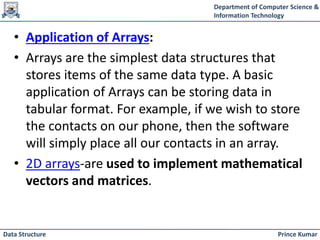
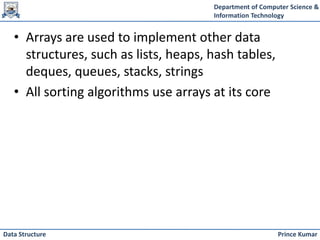
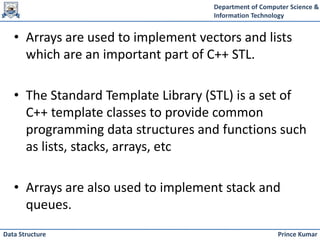
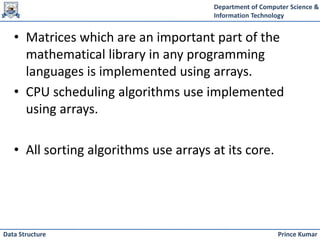
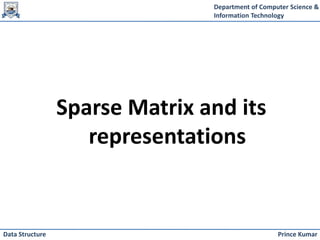
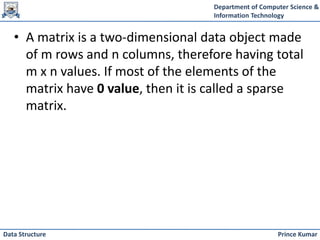

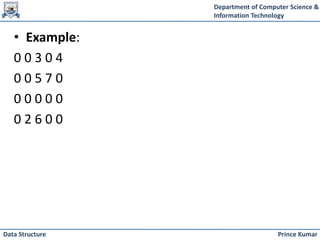


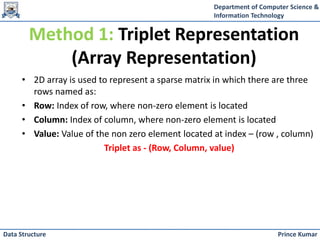
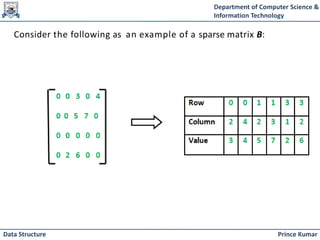
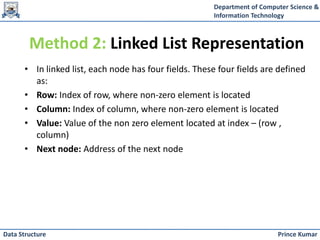
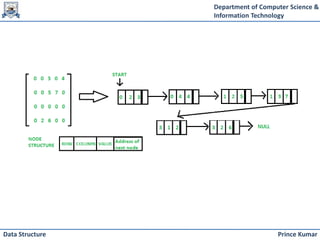

![Department of Computer Science &
Information Technology
Prince Kumar
Data Structure
Array is A(m1,m2,....mn)
We have to find address of A[k1][k2]...[kn]
Where 1<=k1<m1,
1<=k2<m2,
1<=kn<mn
Li=UB-LB+1 (Li is length of ith dimension)
and
Ei=Ki-LB (Where Ei is effective address(It is distance from lower bound to
ith subscript))
Row major order
Address of A[k1 k2 .....kn]=BA+W*[(((E1*L2+E2)L3+E3)L4......En-1)Ln+En]](https://image.slidesharecdn.com/datastructurearrayandsparsematrix-240131151926-f589454c/85/Data-Structure_Array_and_sparse-matrix-pptx-48-320.jpg)
![Department of Computer Science &
Information Technology
Prince Kumar
Data Structure
Address of A[k1 k2 .....kn]=BA+W*[(((E1*L2+E2)L3+E3)L4......En-1)Ln+En]
Example:-
M(2:8, -4:1, 6:10)
Address of M[5,-1,8]=?
B.A=200
L1=8-2+1=7
L2=1-(-4)+1=6
L3=10-6+1=5
E1=5-2=3
E2=-1-(-4)=3
E3=8-6=2
E1*L2=3*6=18
E1*L2+E2=18+3=21
(E1*L2+E2)L3=21*5=105
(E1*L2+E2)L3+E3=105+2=107
M[5,-1,8]=200+4*107=628](https://image.slidesharecdn.com/datastructurearrayandsparsematrix-240131151926-f589454c/85/Data-Structure_Array_and_sparse-matrix-pptx-49-320.jpg)